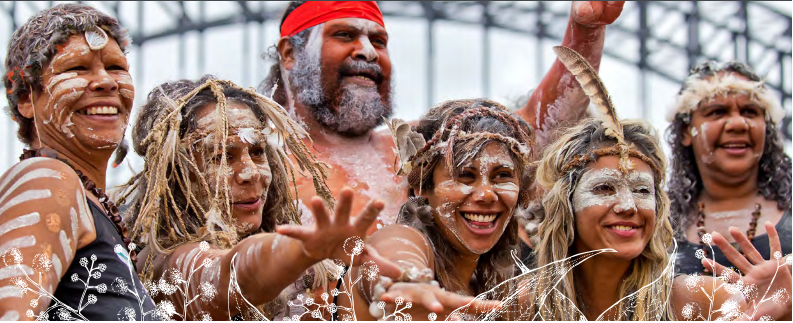At the citizenship ceremony, you pledge your loyalty to Australia and its people. It is therefore important for you to have an understanding of Australia’s community and population, including our Indigenous heritage. It is also important for you to understand Australia’s history and how we have developed into a stable and successful multicultural nation.
In this section, you will read about some of the events that have contributed to our story. There is information about our states and territories, and the traditions and symbols that we proudly identify as being distinctly Australian.
Aboriginal and Torres Strait Islander peoples
Australia’s frst inhabitants are the Aboriginal and Torres Strait Islander peoples, who have the oldest continuous cultures and traditions in the world.
Historically, Aboriginal people are from mainland Australia and Tasmania. The archaeological record indicates that Aboriginal peoples arrived in Australia between 65,000 and 40,000 years ago; however, the Aboriginal peoples believe they are central to the creation stories of this land, and their creation stories commence with the beginning of time. Torres Strait Islander people are from islands between the northern tip of Queensland and Papua New Guinea.
Aboriginal and Torres Strait Islander peoples have age-old beliefs and traditions that still guide them today.
They have a deep connection with the land, which is expressed in their stories, art and dance. Indigenous cultures are diverse and an important part of Australia’s national identity.
More information about Aboriginal and Torres Strait Islander peoples can be found in Part 5, Australia today and Part 6, Our Australian story.
Early days of European settlement
European settlement started when the first 11 convict ships, which became known as the ‘First Fleet’, arrived from Great Britain on 26 January 1788.
At this time British laws were harsh and the jails could not hold the large number of people imprisoned for their crimes. To manage this problem, the British Government decided to transport convicts to the other side of the world: to the new colony of New South Wales.
The first Governor of the colony of New South Wales was Captain Arthur Phillip. The colony survived, and as more convicts and free settlers arrived, it grew and developed. More colonies were established in other parts of Australia.
Early free settlers came from Great Britain and Ireland. This British and Irish heritage has had a major influence on Australia’s recent history, culture and politics.
In 1851, a ‘gold rush’ began when gold was discovered in the colonies of New South Wales and Victoria. People from all around the world came to these colonies to try to make their fortunes. Chinese people arriving at this time were the first large group of migrants not from Europe. In 10 years, Australia’s population more than doubled.

